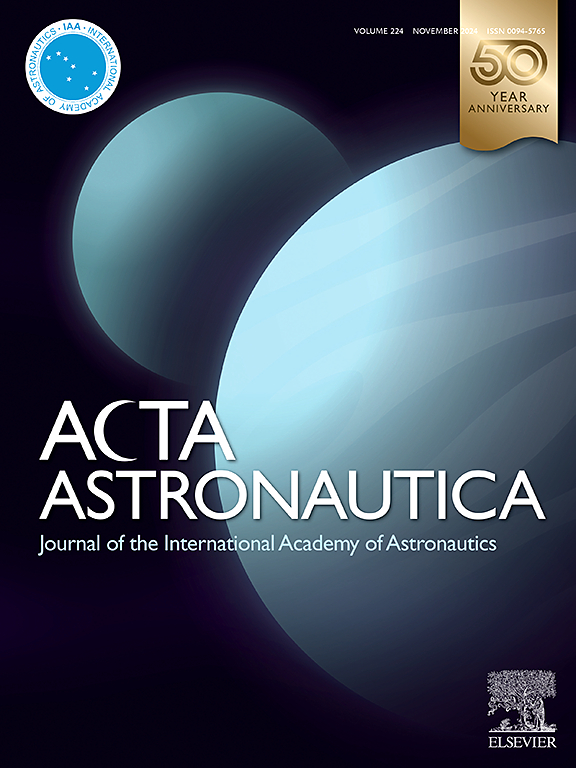Martian buildings: Feasible cement/concrete for onsite sustainable construction from the structural point of view
IF 3.1
2区 物理与天体物理
Q1 ENGINEERING, AEROSPACE
引用次数: 0
Abstract
Colonizing other planets, like Mars, marks a significant milestone in the pursuit of a multi-planetary existence. Millions of people would settle on Mars in self-sufficient bases. Colonizing Mars is a long-term mission that demands self-sufficient, secure habitats and comprehensive planning. Importing structures, such as inflatable structures, from Earth is cost-prohibitive, making the utilization of in-situ resources and onsite construction the most viable approach for preparing the required buildings. Studies have shown that it is possible to produce and craft several kinds of binders and concretes with appropriate mechanical behavior using Martian soil composition; however, determining the optimal option for onsite construction remains a challenge. This study investigates available cement/concrete options for onsite construction on Mars from a structural engineering perspective, taking into account the available resources and technologies. In this regard, the observations and data provided by Martian landers, rovers, orbiters and methods such as Viking-1 & 2, Pathfinder, Spirit, Opportunity, Curiosity, Mars Express, Ultraviolet–visible/Near-infrared reflectivity spectra and Alpha particle X-ray spectrometer were used to obtain a comprehensive and detailed investigation. Eleven types of Martian cement/concrete based on the in-situ resources, soil composition, and available technologies were compared based on the criteria and indices defined in accordance with the structural engineering point of view to select the best practical option for onsite construction. These criteria encompass factors such as mechanical behavior, Martian structural loads, raw material accessibility, available sources, energy required for production, water requirement, curing and hardening time, possibility of using 3D printers, byproduct usefulness, conditions required for hardening and curing, importation requirements from Earth, production complexity, long-term durability and behavior under galactic cosmic rays (GCRs) and solar energetic particles (SEPs). The pros and cons of each cement/concrete option are thoroughly assessed, considering the harsh conditions on Mars. Additionally, the study highlights extra considerations that are crucial for onsite construction on Mars. To determine the best practical option for onsite construction and sustainable colonization, the proposed cements/concretes were compared using multi-scale spider/radar diagrams and a quantitative point of view. This perspective was enabled by assigning weights to each criterion through expert consultation, experimental data, and literature review, ensuring that the diagrams accurately reflect the features of each concrete mix. This comprehensive investigation aims to provide valuable insights into selecting the most suitable cement/concrete for onsite construction on Mars, considering the structural engineering perspective and the long-term goal of sustainable colonization.
火星建筑:从结构角度看现场可持续建筑的水泥/混凝土可行性
殖民火星等其他星球是人类追求多行星生存的一个重要里程碑。数百万人将在火星上建立自给自足的基地。殖民火星是一项长期任务,需要自给自足、安全的居住地和全面的规划。从地球进口充气式结构等建筑成本高昂,因此利用原地资源和现场施工是准备所需建筑的最可行方法。研究表明,利用火星土壤成分可以生产和制作多种具有适当机械性能的粘结剂和混凝土;然而,确定现场施工的最佳方案仍然是一项挑战。本研究从结构工程的角度出发,考虑到现有的资源和技术,对火星现场施工可用的水泥/混凝土方案进行了研究。在这方面,利用火星登陆器、漫游车、轨道器和方法(如维京 1 号和amp; 2 号、探路者、精神号、机遇号、好奇号、火星快车、紫外线-可见光/近红外反射光谱仪和阿尔法粒子 X 射线光谱仪)提供的观测结果和数据进行了全面详细的调查。根据结构工程学观点确定的标准和指数,对基于原地资源、土壤成分和现有技术的 11 种火星水泥/混凝土进行了比较,以选择现场施工的最佳实用方案。这些标准包括机械性能、火星结构荷载、原材料的可获得性、可用资源、生产所需的能源、水需求、固化和硬化时间、使用 3D 打印机的可能性、副产品的实用性、硬化和固化所需的条件、从地球进口的要求、生产的复杂性、长期耐久性以及在银河宇宙射线(GCR)和太阳高能粒子(SEP)下的性能等因素。考虑到火星上的恶劣条件,对每种水泥/混凝土方案的利弊进行了全面评估。此外,研究还强调了对火星现场施工至关重要的额外考虑因素。为了确定现场施工和可持续殖民化的最佳实用方案,使用多尺度蜘蛛/雷达图和定量观点对建议的水泥/混凝土进行了比较。通过专家咨询、实验数据和文献综述为每项标准分配权重,确保图表准确反映每种混凝土混合物的特点。这项综合调查旨在从结构工程角度和可持续殖民的长期目标出发,为选择最适合火星现场施工的水泥/混凝土提供有价值的见解。
本文章由计算机程序翻译,如有差异,请以英文原文为准。
求助全文
约1分钟内获得全文
求助全文
来源期刊

Acta Astronautica
工程技术-工程:宇航
CiteScore
7.20
自引率
22.90%
发文量
599
审稿时长
53 days
期刊介绍:
Acta Astronautica is sponsored by the International Academy of Astronautics. Content is based on original contributions in all fields of basic, engineering, life and social space sciences and of space technology related to:
The peaceful scientific exploration of space,
Its exploitation for human welfare and progress,
Conception, design, development and operation of space-borne and Earth-based systems,
In addition to regular issues, the journal publishes selected proceedings of the annual International Astronautical Congress (IAC), transactions of the IAA and special issues on topics of current interest, such as microgravity, space station technology, geostationary orbits, and space economics. Other subject areas include satellite technology, space transportation and communications, space energy, power and propulsion, astrodynamics, extraterrestrial intelligence and Earth observations.
 求助内容:
求助内容: 应助结果提醒方式:
应助结果提醒方式:


